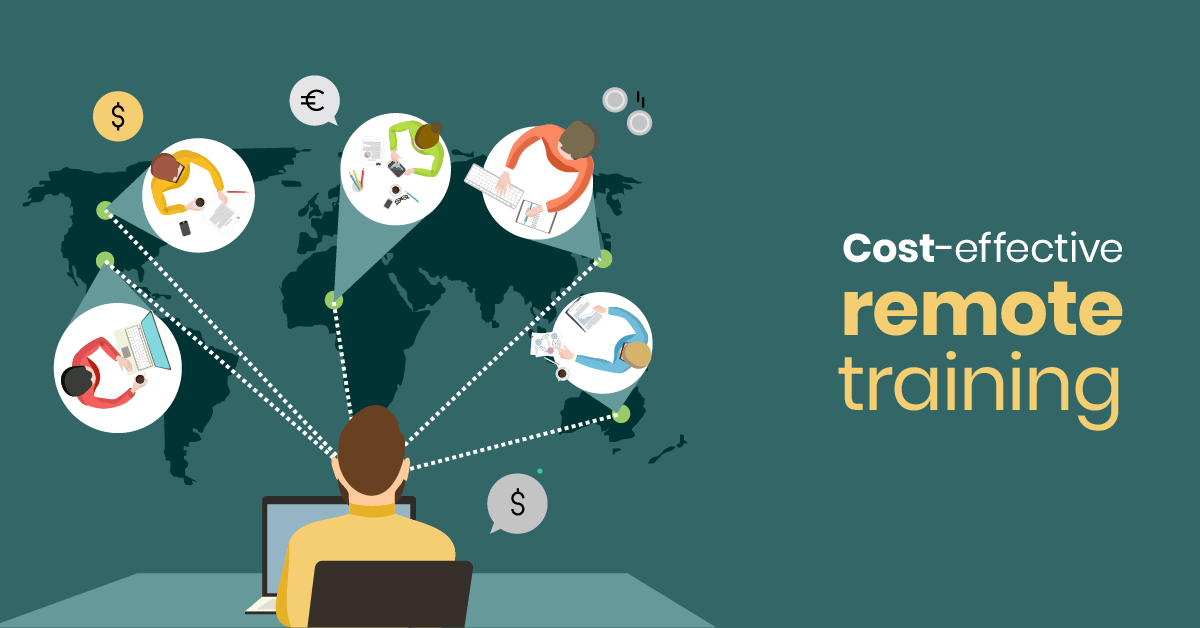But there is a way to create training that brings results without breaking the bank. Even when you don’t operate with the typical in-office workforce.
In this post, you’ll learn what remote learning is and how it differs from online, its benefits, and how to deploy effective remote training without sinking your budget. Ready when you are!
What is remote learning? How is it different from online learning?
Online and remote learning are two terms used interchangeably. The truth is that the difference between them is so subtle that it justifies the confusion.
Remote training is when instructors and learners are in different locations, so the training takes place online. This happens when a company operates with a remote workforce. Other times, because it has several branches and wants to offer streamlined, consistent training. Circumstances, like the current pandemic, can also lead companies to deploy remote training.
On the other hand, online training is when all or some of the training takes place online even if the instructor and the learners are in the same location. Online training occurs when, for example, you upload your learning material and create assignments and tests on a training platform. More often than not, both types of training allow for asynchronous, self-paced learning.
Remote training benefits
On many occasions, remote learning is a better alternative to on-site training and offers benefits that make it more attractive to employers and employees alike:
Cost-efficiency
By definition, remote training unburdens you from many of the standard on-site training costs that involve instructor fees, accommodation and travel expenses, and venue booking.
Flexibility
Remote learning is, in its largest part, asynchronous with only a few synchronous sessions, or none at all. The self-paced element makes it a flexible solution that doesn’t distract employees from their work. Employees are able to resume their training when they are not busy, and not when it’s “marked so” on their calendars.
Easy deployment
Can you imagine (or have you ever lived the nightmare of) organizing classroom training for offices across different regions or cities? Having to book tickets, a venue, and possibly a catering service for day-long events, work out a schedule that causes the least possible inconvenience, and arrange accommodations is a task no one wants to be picked for. With remote training, you can forget all that.
Accessibility
Modern workplaces pride themselves on offering equal development opportunities to all employees. These opportunities start with training employees properly and offering them knowledge and skills that they can use inside and outside the workplace.
However, this wasn’t the case for remote and mobile employees who, during the (dark) ages when remote learning was an unknown concept, were deprived of basic onboarding — let alone further L&D opportunities.

Creating cost-effective remote training
Remote training can be both budget-friendly and effective if you’re smart about it. Are you taking notes?
1. Assess the skills gap among your workforce
Although it’s generally recommended to upskill your workforce before the times catch up with you, you shouldn’t rush employee training. First, you need to find where your gaps are. For example, a drop in performance can mean you have the wrong manager in place or the wrong software installed on your employees’ desktops. Before deciding that training is the only way to boost employee performance, talk with your managers and employees to find out what the problem really is.
You also have to know the extent of the problem and existing skills gaps in your company before creating a training plan. Otherwise, training won’t fix much, and you will have to do it all over again. (And this costs.) So if you have a specific issue you want to address, conduct pre-assessment tests to gauge your employees’ knowledge level and create a course that is right for them.
2. Choose the right remote training tools
Developing remote training doesn’t necessarily mean you have to go big and invest in a myriad of training tools. For instance, if you are looking to cover a quick training need, you can use your video conferencing tool, record a webinar, and share it with employees.
And if you are in it for the long haul? If you have decided to make training part of your company culture, you will need remote training software. Depending on the company size and number of employees, you might need more or fewer features. Make thorough research to pick a tool that covers your needs and that you’re confident your employees will be able to use.
A user-friendly LMS will make your job easier since you’ll be able to create and update your courses in a few steps. Ideally, look for a Learning Management System that also offers ready-made courses. Off-the-shelf content is a budget-friendly and reliable solution for standardized types of training, like data security and soft skills enhancement. Since remote training often needs to accommodate mobile employees, an LMS with a mobile app will do just the trick for your deskless workforce, like drivers and retail assistants.
3. Don’t start from scratch
Even if you’re developing remote training for the first time, you don’t have to create a course out of nowhere. For example, you can buy ready-made courses either from your training platform’s marketplace or educational institutions that sell their courses online. You can also repurpose content you already have, like recorded seminars, presentations, infographics, and company guidelines.
Sometimes, creating a course is as simple as putting together, in one place, content you have occasionally shared or created, and adding some new material.
4. Use your own Subject Matter Experts
It’s important that the course you offer your employees contains accurate and up-to-date information. This can be easily arranged by consulting a Subject Matter Expert or buying off-the-shelf content. In the spirit of cost-effectiveness though, and when the content needs to be tailor-made, you might not even have to bring in a Subject Matter Expert.
There might as well be a pool of SMEs under your nose. Like seasoned salespeople who can share their expertise or IT employees to train employees on data security.
5. Measure training success
Although this is something you do after training, measuring training effectiveness can help you save money in the future. There are several ways to get feedback to find out whether your remote training program was successful and how it can be improved. More specifically:
- LMS data: If you are using an LMS, your job at this point is easy. Auto-generated reports provide you with training KPIs, like participation and completion rates. They can also give you insights about engagement with content and the difficulty level of the course. Multiple attempts to pass a test, for example, indicate that the course is too difficult or the content is hard to digest.
- Learner feedback: Conduct a survey to get direct employee feedback. Did the course resonate with them? Did employees use what they learned on the job? Did they enjoy the content?
- Business KPIs: A strong indication of training effectiveness is whether employees are reaching their goals and KPIs. Just remember that numbers can’t tell you the whole story, so don’t over-rely on them. E.g., managers play a huge part in enabling employees to unfold their potential and practice new skills.
Conclusion
Whether in training, work, or relationships, it’s hard to fight off the lack of immediate interaction and transparency when you’re not in the same location. When it comes to remote training, using the right tools, like user-friendly remote training software, can make all the difference.
Then, it’s also a matter of assigning an enthusiastic manager who creates opportunities on the job and encourages continuous education and development. With the best resources — human and software — you can create cost-effective training that beats the distance without straining your budget.



